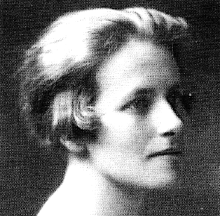
Alison Shepherd was born Alison Sleigh in Dunedin, New Zealand on 8 March 1898 and grew up in Christchurch. After studying art at Canterbury College she was articled to Samuel Hurst Seager (1855-1933) in Christchurch in 1917. She completed her articles in the office of Cecil Walter Wood (1878-1947) in Christchurch. In April 1921 she moved to England to complete her architectural education at the Architectural Association in London.
At the AA she met Elisabeth Whitworth Scott (1898-1972), who in 1927 won the competition to design the new Royal Shakespeare Theatre in Stratford-upon-Avon. In the 1929, with Scott, Maurice Chesterton (1883-1962), John Chiene Shepherd (1896-1978), she formed the architectural partnership Scott, Chesteron & Shepherd. [Sleigh had married Shepherd in 1928 and by this time had changed her surname to Shepherd].
By 1934 Chesterton appears to have withdrawn from the partnership to be replaced by John Breakwell (c.1905-1959). The name of the practice was subsequently renamed Scott, Shepherd & Breakwell.
Notable among projects by them was the Fawcett Building at Newnham College, Cambridge, completed in 1938. A house in Clapham, Sussex designed by Scott, Shepherd & Breakwell is discussed in Small Houses £500-£2500, edited by H. Myles Wright (1937 p. 89).
While a student at the Architectural Association in the 1920s Shepherd met Janet Fletcher (1904-?). They worked together on a number of architectural projects as J. Fletcher & A. Shepherd in the early 1930s and designed a three-bedroomed model flat for the first 'New Homes for Old' exhibit at the Building Trades Exhibition at Olympia in 1932. A kitchen designed by them for a workers' canteen in North Kensington, London is discussed, with a photograph in Design in Modern Life (London: BBC, 1933 p.x), a pamphlet issued to accompany a series of talks on contemporary design broadcast by the BBC between April and June 1933.
Shepherd was elected an Associate of the Royal Institute of British Architects (ARIBA) in June 1927. She is believed to have been the first New Zealand woman to have been elected an ARIBA. Her address was given as The Pond House, Stoke Row, near Henley-on-Thames, Oxfordshire in 1950. She retired as an architect in 1957 and died on 20 October 1972.
AA Women in Architecture 1917-2017. Edited by Elizabeth Darling and Lynne Walker. London: Architectural Association an the authors, 2017 [Listed as Alison Sleigh]
Darling, Elizabeth. ‘‘Enriching and enlarging the whole sphere of human activities’: the work of the voluntary sector in housing reform in inter-war Britain’ in Regenerating England: Science, Medicine and Culture in Inter-War Britain. Edited by Christopher Lawrence and Anna-K. Mayer. Amsterdam: Editions Rodopi, 2000 pp. 149-178
Gatley, Julia. ‘Alison Shepherd (Nee Sleigh), ARIBA: 'Success of New Zealand Lady Student' Revisited’. Fabrications: The Journal of the Society of Architectural Historians, Australia and New Zealand vol.17, no.1, June 2007 pp.20-45 [Abstract: More than simply documenting Alison Shepherd's life and work, this paper attempts to assess the impact her gender might have had on her career; to consider the relationships she might have shared with other expatriate New Zealand architects in Britain in the mid-twentieth century; and to locate her career within the broader context of burgeoning British modernism].
Gatley, Julia. Introducing . . . Alison Shepherd. ARIBA'. The Architectural Historian issue 14, May 2022 pp. 22-23